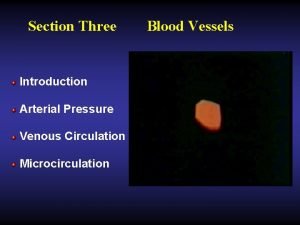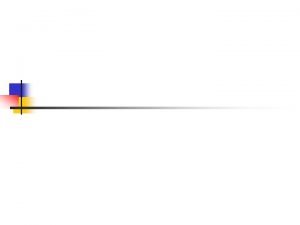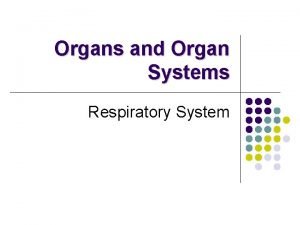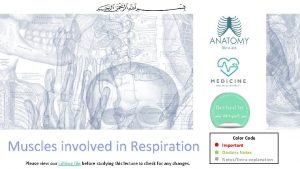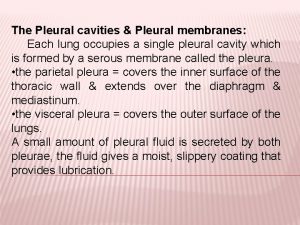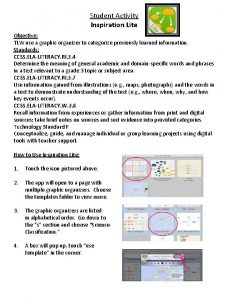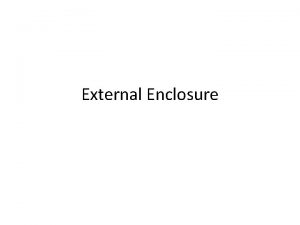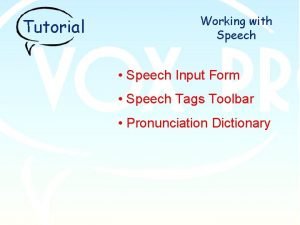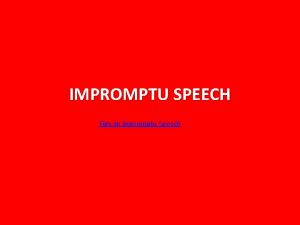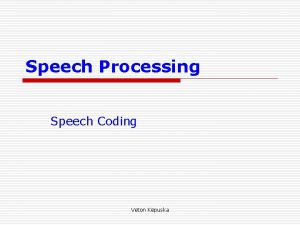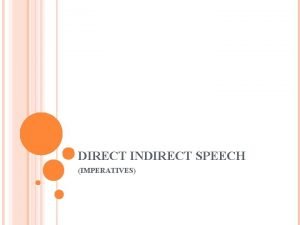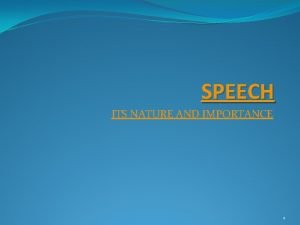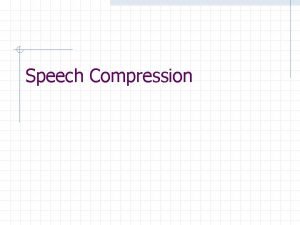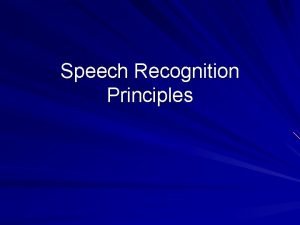Speech Summary Inspiration Inspiration Diaphrag m down External



























- Slides: 27

Speech Summary

Inspiration

Inspiration Diaphrag m: down External Intercostal s: ribs up and out Abdominal Muscles: down and out

How do we breathe? Boyle’s Law: PV = constant • P = pressure • V = volume Air moves from areas of high pressure to areas of low pressure http: //sciencesquad. questacon. edu. au/activities/model_lung. h

Upper Airway http: //www. easyrent. tj/001_lib/002_anatomy_3 d/3 d_models/human_anatomy/male_systems/Male_Respiratory_3. php

Respiratory Passage http: //academic. kellogg. edu/herbrandsonc/bio 201_mckinley/Respiratory%20 System. htm

Trachea http: //www. naturalhealthschool. com/bronchi_trachea. html

Lung Volume Hixon, T. J. , et al. (2008). Preclinical Speech Science: Anatomy, Physiology, Acoustics, and Percept

• Phonation threshold pressure (PTP): smallest subglottal pressure needed to start self-sustained oscillation • For low frequency phonation, PTP is around 3 -4 cm H 20

Nonuniform tissue movement: Multimass models • Upper and lower parts of the vocal folds do not move as one • The lower part of the vocal folds moves first, followed by the upper part • Convergent: lower further apart than upper • Divergent: upper further apart than lower Titze, I. R. (2000). Principles of Voice Production.

Innervation • Vagus (CN X) • Superior laryngeal nerve: • Cricothyroid (CT) • Recurrent laryngeal nerve: • Thyroarytenoid (TA) • Posterior Cricoarytenoid (PCA) • Lateral Cricoarytenoids (LCA) • Interarytenoids (IA) Blumenfeld, H. , 2002, Neuroanatomy through Clinical Cases, Sinauer, Inc.

ABduction & ADduction • PCA: • Rocks arytenoids away from midline • ABducts the vocal folds • LCA: • Rocks arytenoids toward midline • ADducts the vocal folds Hixon, T. J. , et al. (2008). Preclinical Speech Science: Anatomy Physiology Acoustics Percept

Interarytenoids • Transverse: • Pulls arytenoids toward each other • ADducts the vocal folds • Oblique: • Tips one arytenoid (apex) toward the other (body) • ADducts the vocal folds Hixon, T. J. , et al. (2008). Preclinical Speech Science: Anatomy Physiology Acoustics Percept

TA and CT: Activation Patterns • CT active and TA passive = increase pitch • Increase length • Increase stiffness • TA active and CT passive = decrease pitch • Decrease length • Decrease stiffness • TA and CT contract simultaneously = increase pitch • Increase stiffness

Mouth Transmitted Impedance Pharynx Reflected Glottis Incident

Vocal Tract: Single Tube • Vocal tracts have more than one resonance (formant) • The following equation is used to find the frequency of a specific formant: Fn = (2 n-1)(c/4 L) F = formant number L = vocal tract length

Basics of Resonance Source-Filter Theory of Voice Production Source = vocal folds (glottis) Filter = vocal tract (pharynx/oral cavity) “Whereas the glottis produces a sound of many frequencies, the vocal tract selects (filters) a subset of these frequencies for radiation from the mouth. ” Note: This theory states that the vocal folds produce the fundamental frequency (pitch)- the vocal tract does Quote from: Titze, I. R. (2000). Principles of Voice Production.

Formants • As the vocal tract lengthens, the formant frequencies decrease • Shortening leads to an increase in formant frequencies • Some ways you can influence vocal tract length: • Lengthening: lowering larynx and/or lip rounding • Shortening: raising larynx and/or lip retracting • Your book states that the larynx can be raised or

Resonance • Titze 163 Titze, I. R. (2000). Principles of Voice Production.

Tongue Hixon, T. J. , et al. (2008). Preclinical Speech Science: Anatomy, Physiology, Acoustics,

Hypoglossal (CN XII) • MOTOR ONLY • Tongue http: //medical-dictionary. thefreedictionary. com/CN+X

Soft Palate • When the soft palate is lowered (Tensor veli palatini, Palatoglossus), air enters the nose • Resonance between 300 -500 Hz Zemlin, pg 264.

Vagus (CN X) • Pharyngeal • Pharynx • Soft palate • Gag • Superior laryngeal • Pharyngeal constrictor • Larynx • Recurrent laryngeal • Larynx Blumenfeld, H. , 2002, Neuroanatomy through Clinical Cases, Sinauer, Inc.

Mandible: Lowering • Digastricus • Mylohyoid • Geniohyoid • Connect jaw and hyoid • Contraction: raise hyoid, depress jaw

Teeth Zemlin, pg 240.

Hixon, T. J. , et al. (2008). Preclinical Speech Science: Anatomy, Physiology, Acoustics,

Facial (CN VII) Buccal Zygomatic Mandibular Temporal Cervical • Facial Expression • Forehead: Temporal • Blink: Zygomatic • Nose: Buccal • Lips: Buccal • Jaw: Mandibular & Cervical http: //www. riversideonline. com/health_reference/Nervous-
 External-external trips
External-external trips Our father all of heaven
Our father all of heaven Stand up sit down hands up hands down
Stand up sit down hands up hands down Here i bow down here i bow down
Here i bow down here i bow down Book
Book I fled him
I fled him Write down six words from juliet's speech
Write down six words from juliet's speech Down parts of speech
Down parts of speech Upper respiratory tract consists of
Upper respiratory tract consists of Inspiration and venous return
Inspiration and venous return Plenary inspiration
Plenary inspiration What is windpipe called
What is windpipe called What are inspiratory muscles
What are inspiratory muscles Difference between inspire and motivate
Difference between inspire and motivate Proof of inspiration 2
Proof of inspiration 2 Conceptual inspiration
Conceptual inspiration Dynamic inspiration
Dynamic inspiration All scripture is given by inspiration
All scripture is given by inspiration Romantic era music history
Romantic era music history L'inspiration est un phénomène passif ou actif
L'inspiration est un phénomène passif ou actif Dystopian inspiration
Dystopian inspiration Inspiration in the bible definition
Inspiration in the bible definition Inspiration management
Inspiration management Inspiration graphic organizer
Inspiration graphic organizer Muscle of inspiration and expiration
Muscle of inspiration and expiration Inspiration lite
Inspiration lite Great grey owl
Great grey owl What does inspiration mean
What does inspiration mean









